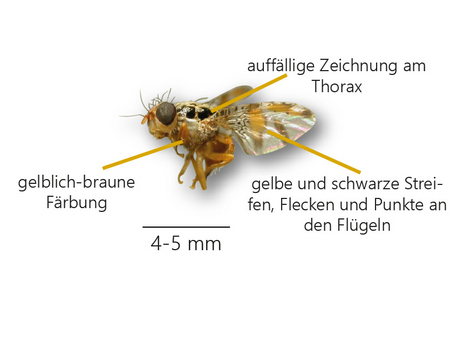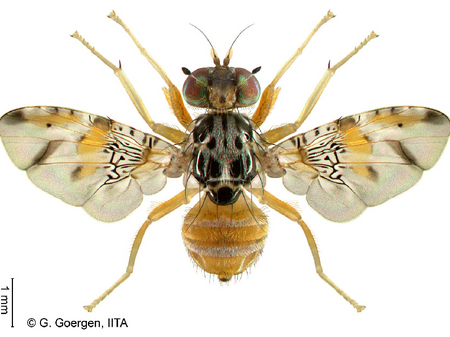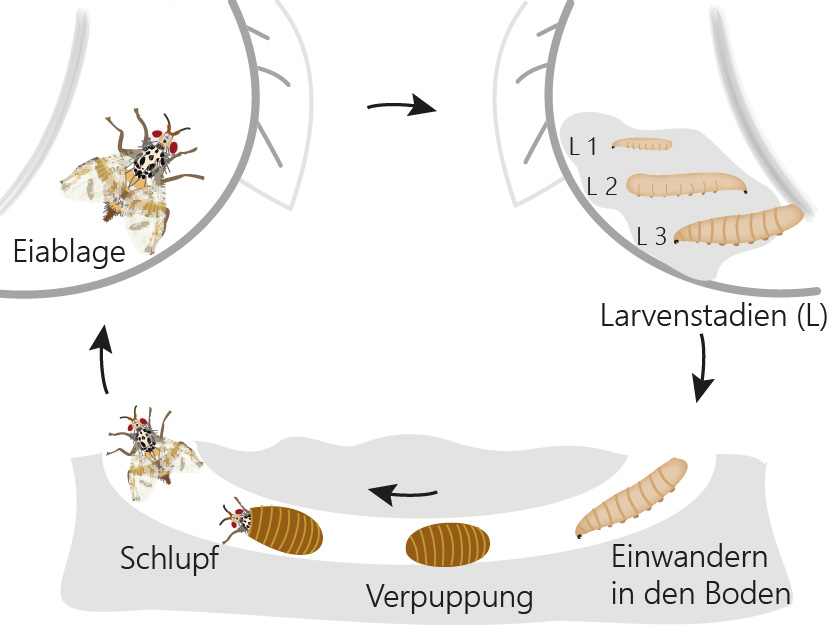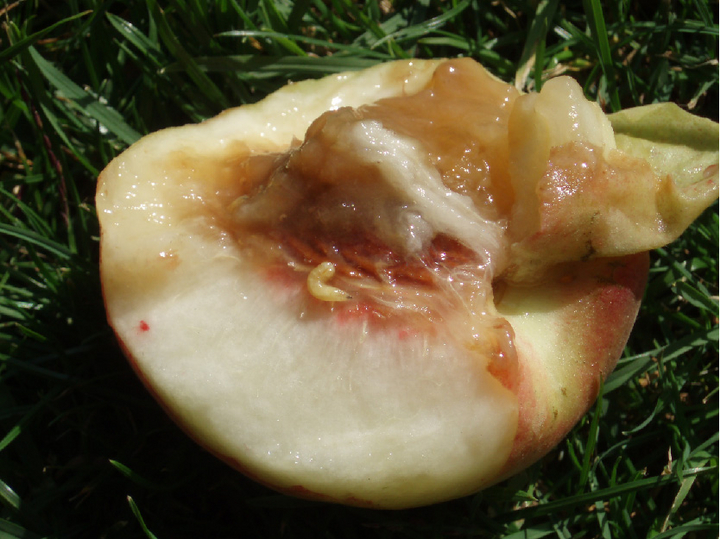Mediterranean fruit fly
Ceratitis capitata
Appearance
The adult flies are about 4-5 mm in size, yellowish-brown and are characterized by strikingly colored wings (yellow and black stripes, spots and dots) and a conspicuous pattern on the back of the thorax. However, there is a risk of confusion with other fruit fly species.
The larvae of the Mediterranean fruit fly are white to cream-colored, up to 1 cm long in the last larval stage and have a black mouth hook.



Die Abbildung der adulten Mittelmeerfruchtfliege "Ceratitis capitata" von G. Goergen IITA ist lizenziert unter CC BY 4.0
Biology
After mating, the females lay the eggs under the skin of ripening fruit. After a few days, the eggs hatch into larvae, which feed in the fruit and develop there from the first to the third larval stage. They then leave the fruit and drop to the ground. In the soil under the host plant, pupation occurs, and the adults hatch from the pupae. At optimal temperatures (25-30 °C, laboratory conditions), the Mediterranean fruit fly can complete its development cycle in about three weeks. In its original range, it goes through several generations per year, depending on climatic conditions.
Due to the climatic conditions prevailing in Austria, they take longer to develop here, which is why only a low number of generations (approximately one to two generations per year) can be assumed. Adult Mediterranean fruit flies can live for several months and the females can lay several hundred eggs during this time. Whether and in what way the Mediterranean fruit fly can survive the cold season in our latitudes has not yet been clarified.

Damage symptoms

In infested fruit, the punctate injection sites of egg laying can be detected. The larval stages feed inside fruits, destroying the flesh and making the fruits more susceptible to secondary pathogens such as fungi. Since the Mediterranean fruit fly only attacks fruit, there is no damage to other parts of the plant such as leaves, trunk, branches or roots.
Host plants
The Mediterranean fruit fly is a highly polyphagous fruit fly with a wide host plant range of over 200 plant species. In Europe, potential host plants include citrus(Citrus spp.) and peach(Prunus persica), as well as a variety of other fruit-bearing plants (cultivated and wild). These include other Prunus species such as apricot(Prunus armeniaca), but also pear (Pyrus spp.), apple(Malus domestica), medlar(Mespilus germanica), kiwi (Actinidia deliciosa) and mango(Mangifera indica).
In Austria, mainly infested peaches, and in isolated cases apricots and pears, have been found at individual allotment sites in Vienna.
Distribution
The Mediterranean fruit fly originates from Africa, but has been found on all continents in recent decades. The main cause of its spread is the carry-over of infested fruit from infested areas through global trade or in the luggage of travelers.
In Austria, the Mediterranean fruit fly has been detected repeatedly over the past century and surveys in recent years have also shown repeated occurrence in the north and east of Austria. Especially in Vienna, adults were caught recurrently and infested fruits were found in allotments; in other northern and eastern provinces, only isolated Mediterranean fruit flies were caught with traps.
Propagation and transmission
Dispersal of the Mediterranean fruit fly can be active or passive. Active dispersal is by flight of adults up to 20 km, passive by wind dispersal over even greater distances. The most important passive dispersal occurs through the transport of infested fruit (commercial goods, travelers' luggage).
Economic importance
Due to changing climatic conditions (milder winters), there is a medium-term risk of permanent establishment of the Mediterranean fruit fly in our latitudes with negative effects for domestic fruit growing. On the one hand, this concerns direct damage to the fruit, on the other hand, an occurrence poses the risk of potential trade barriers for exports to infestation-free countries.
Prevention and control
- To detect the occurrence (monitoring, prevention): placing suitable traps with specific attractants. Different types of traps and attractants are used (e.g. Delta traps, McPhail traps, fruit fly traps, etc.). However, due to possible mutual interference, attractants for males and attractants for females (often protein-based) may only be used at appropriate distances from each other.
- By means of higher trap numbers the population can be reduced (mass trapping).
- In hobby orchards: wrapping or netting fruit when infestation is feared to mechanically prevent oviposition (physical barrier).
- Hygiene in the orchard: regular removal and harmless destruction of infested fruit. Any larvae that may be present in the fruit should be killed, for example by freezing or deep burial of the fruit. Simple composting without treatment is not sufficient, as the animals can continue to develop in the compost.
- Currently, there are no plant protection products approved against this pest in Austria (see list of plant protection products approved in Austria).
Phytosanitary status
Due to its widespread occurrence in southern Europe, the Mediterranean fruit fly is not classified as a quarantine pest in the EU. An occurrence is therefore not reportable. The EPPO lists the Mediterranean fruit fly on the A2 list (= pest locally present in EPPO region; regulation recommended).
Specialized information
Clarification of infestation by the Mediterranean fruit fly
Samples (larvae or adults) can be sent to us for clarification of pest identity (see Plant Health Services), although prior contact is desirable.
Samples may be infested fruit with live larvae (in tightly sealed containers), which should be transmitted to us very quickly. Here, they can either be grown until hatching adults to allow morphological identification, or the larvae can be identified by molecular biology. Killed adults (from developing larvae in fruit or from trap catches) can likewise be transmitted as a sample. Here, care should be taken to ensure cool storage prior to transport.
Research
We continuously conduct surveys on the occurrence of these and other important fruit fly species in Austria. In addition, we participate in international projects on the subject of fruit flies. Within the framework of these, among other things, the overwintering abilities of the Mediterranean fruit fly are tested in Vienna in order to determine whether and how this tropical species can manage overwintering in our latitudes. Further information can be found under the links to EUPHRESCO below.
Publications
Egartner, A., Lethmayer, C., Gottsberger, R., Blümel, S., 2019. recent records of the Mediterranean fruit fly, Ceratitis capitata (Tephritidae, Diptera) in Austria. IOBC-WPRS Bulletin 146, 143-152.
Lethmayer, C., Egartner, A., 2019. invasive flies in domestic fruit crops. Better Fruit 8, 7-8.
Egartner, A., Lethmayer, C., 2017. the Mediterranean fruit fly - current distribution of an "old" new pest. Better Fruit 6, 10-12.
Lethmayer, C., 2011. dangerous flies for apples & co. Better Fruit 12, 4-5.
Links
Information from the EPPO on the Mediterranean fruit fly
EUPHRESCO network (see project acronyms FLYDETECT and FruitFlyRiskManage)
Last updated: 05.12.2024
automatically translated